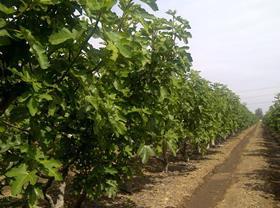
Chile’s Hortofrutícola Sudamericana has set itself the goal of doubling its exports of fresh figs within the next five years.
Since its creation in 1998 the company has been dedicated to the production and export of speciality crops such as radish, artichokes and asparagus for the US market.
“Our goal was to form strong links with producers in California, complementing their production during their off season,” explains the company’s Cristian Muñoz. “Rather than competitors we work together as strategic partners to supply the market throughout the year.”
Today, the main focus of the business is on growing and exporting fresh figs, as well as radish, Brussels sprouts and chestnuts. “Developing new products to replace those that have completed their commercial lifecycle is an ongoing process, and in this sense we are at the vanguard of the fresh produce industry in Latin America,” says Muñoz.
He puts the rising popularity of fresh figs down to two main factors: their high nutritional value and their versatility. “They can be eaten whole, as a dessert, or used in dozens of recipes, both sweet and savoury,” he notes.
The company has around 100ha of farms, of which 60ha are currently under production and the rest under development. Most of its fig orchards are located in the Metropolitan Region, less than an hour’s drive from the international airport at Santiago. Given the highly perishable nature of fresh figs, this is a key advantage as it means the fruit can be loaded for shipment within 24 hours of harvesting.
Chile’s fig window runs from February to the end of May, before the start of the Israeli and Turkish season. Its main Southern Hemisphere competitor is South Africa, although its season does not entirely overlap with Chile’s, leaving plenty of room for both suppliers.
In 2016 Hortofrutícola Sudamericana shipped 100 tonnes of figs –all airflown – and in 2017 it is on course to exceed 120 tonnes. Accounting for half its volume, the US remains its principal market, followed by the UK (30 per cent), France and Canada. It now has a number of new markets within its sights, including Scandinavia, Hong Kong, Japan and China, and has visited each of these with the aim of gaining a greater understanding of their consumers before commencing trial shipments.
“Ours is very much a speciality product and it therefore takes a lot of patience and perseverance to introduce them to a new market and iron out any teething problems, particularly in the area of logistics and the cold chain infrastructure at the final destination,”
Commenting on the long-term outlook for fresh figs, Muñoz thinks there is still a way to go before the company realises its potential.
“Next February the company will be 20 years old and during the past two decades we have seen speciality products come and go. In the case of figs I believe the limit lies in the space available on airfreight services,” Muñoz says.
“Our objective is to double our export volume in the next five years. I like to imagine that we are selling perfume in that we’re looking to supply small quantities to the highest possible number of specialist stores and cities.”






No comments yet